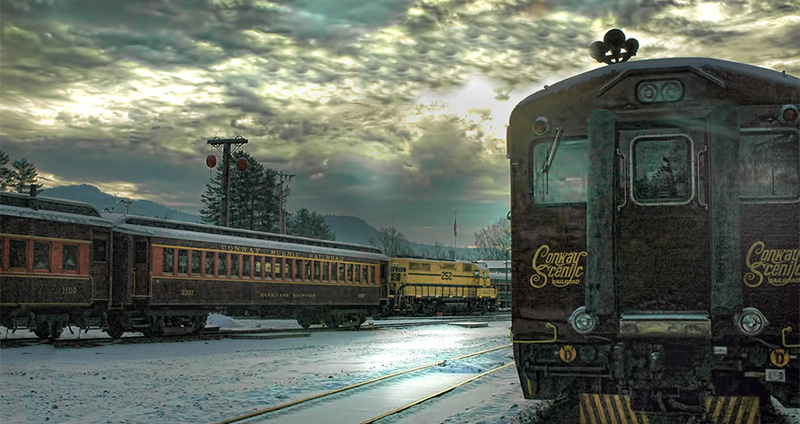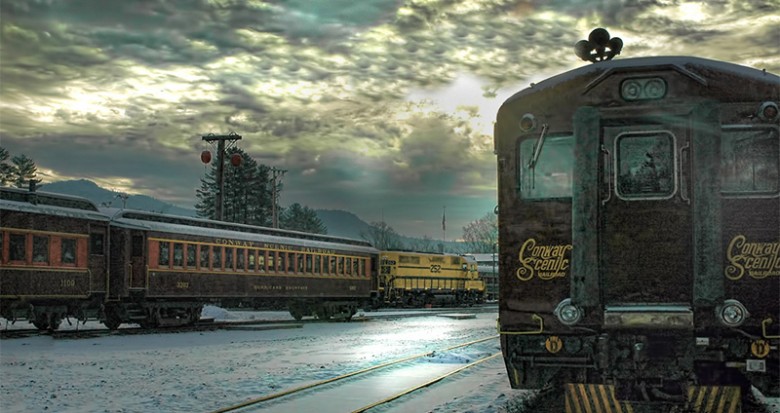All Aboard the Polar Express | Yankee Classic
Every Christmas, families across NH are magically transported to the North Pole by train. Learn more about the Polar Express experience in this 1998 Yankee Classic.

All Aboard the Polar Express | Excerpt from Yankee Magazine, December 1998
Photo Credit : Lydia Williams
Photo Credit : Lydia Williams
Where are we going?” my mother asks. I sit wedged between her and Ian, my three-year-old son, on a bench seat made for two. Our train rocks and creaks through the New Hampshire darkness.
“The North Pole,” Ian and I say at the same time.
“No, you know,” she whispers now, her hand over her mouth. “I mean, which town?”
“Mom, we’re heading to the North Pole.” I whisper back out of the side of my mouth. “To be greeted by elves and see Santa Claus. To see him pack his sleigh and pick a child to receive the first gift of Christmas.”
She sighs, sits back, and bites into a piece of candy — chocolate with a white nougat center. Ian tries to chew the entire golf-ball-sized candy and stares out the steaming-up window.
“Is it Glen?” my mother whispers again. “Bartlett? Where in this valley would they be able to build a North Pole?”
I just smile and shake my head. “Mom,” I tell her, “you’ve got to believe.”
All around us, on car number four and the other cars of the Conway Scenic Railroad, children drink hot chocolate, eat candy, and stare out the windows of the train at the swiftly passing night. This train, they’ve heard, will take them to the North Pole to see Santa Claus, just as it took the young boy in The Polar Express.
Written and illustrated in 1985 by Providence, Rhode Island, resident Chris Van Allsburg, The Polar Express has become a holiday classic. It tells the story of a young boy whose friends tell him there is no Santa Claus. He refuses to believe it, and on Christmas Eve he lies in bed, listening for the sound of hooves on the roof. Instead, he hears a train’s whistle. He creeps downstairs and boards the train destined for the North Pole. On the way, the boy and dozens of other children pass through dense forests and deep valleys. Wild animals scatter as they rush by. At the North Pole, Santa and the elves prepare feverishly for the trip around the world. Santa picks one child — the boy in the story — to receive the first gift of Christmas. Though he can have anything he chooses, he asks Santa for a bell from his sleigh. On the train home, the boy loses the bell through a hole in his bathrobe, only to find it again, wrapped up under the tree on Christmas morning. He loves the way it sounds, but his parents can’t hear it. Only believers can hear the bell. For the rest of his life, he will hear it.
When we boarded the train at the restored turn-of-the-century station in North Conway village, we could see lights sparkling on Mount Cranmore. To Ian they looked like stars so close he could almost touch them. Inside, we sat on leather seats with curved arms; the oak paneling, the high ceilings, etched-glass doors and transoms made us feel we were traveling in another era. In the spring, summer, and fall, the trains of the Conway Scenic Railroad carry passengers on scenic tours of the Mount Washington Valley. But on December weekends, in the chill of the evening, the trains depart for only one destination: the North Pole. Some years ago, after reading Chris Van Allsburg’s book, several local folks thought of using the Conway Scenic Railroad to reenact the North Pole journey. The first year, there were five trips; in 1997 there were ten, all of them sold out.
If you truly need to know where the train is going, one of the 300 local volunteers might tell you that the train goes from Conway to Bartlett. The North Pole, if you insist, is the Bear Peak Lodge at Attitash. Every weekend evening, volunteers labor mightily to convert the lodge into the North Pole and Santa’s workshop. The profits from the train rides are used to promote literacy programs in the valley. And those volunteers — 90 are needed each night — dress up as elves, complete with red velvet suits, pointy shoes, and hats with bells. The volunteers become chefs, too, who ride the trains in snow-white toques, serving hot chocolate and chocolate nougat candies.
Carolers in blue velvet come down the train aisles singing “O Christmas Tree.” All around us, some children sing, most chatter. They’re dressed in PolarFleece, stocking caps, pajamas, and flannel nighties. Some have teddy bears. Some are rehearsing what they will tell Santa if he asks them what they want. “I want a Barbie,” I hear, and “Hot Wheels garage!” Even the grown-ups are giddy. There’s jostling and hot-chocolate splashing. A little sister gets elbowed off a seat near a window and I hear parents whispering of “time-outs.”
Outside, the full moon shines on the snow, on birches, balsams, and firs. We come to a crossing. The train whistles and cars wait as we pass through a little town. We spot a Mobil station and some grown-up remarks about how unusual it is to “see a Mobil station this close to the North Pole.” My mother chuckles.
Ian wipes steam from the window and looks out. In a clearing is a farmhouse, candles in each window. A man wearing a Santa hat steps onto the front porch and waves to us. The train picks up speed, and we rush through forests of dusky pines, the outlines of hills in the distance. There are fewer houses on winding roads; the snow deepens. In the woods, faraway lights from faraway cottages flicker in the dark. Looking up at the sky (for reindeer?), Ian, struggling around the giant nougat candy in his cheek, says, “It’s so nice, Mummy.”
“There’s a swing year,” my mother whispers to me. “Usually around seven or eight years old. They want to believe in Santa still, but everything — their friends, maybe an older brother, their own reasoning — points to not believing. The eight-year-olds lobby hard for you to tell them about Santa’s real identity. But you can see them wavering,” she says. “They hedge their bets, because they think if they don’t believe, they won’t get any presents. So for a while, they decide to believe.”
The train slows; we must be getting close. Doors open and conductors in crisp blue uniforms and hats stride through. The lights come up and the noise level, if possible, goes up. I prepare Ian for the North Pole: He’ll need to wear his hat, scarf, and mittens.
“He knows if you’ve been bad or good?” he asks me.
“He does,” I say. “But you have been very, very good. You were born that way.”
Helped by elves in red velvet, we step off the train and walk through a tunnel of elves holding lanterns along a path up toward Santa’s workshop. Outside the workshop, elves drag a huge red sack of toys toward Santa’s parked sleigh.
“Mom, this is cooool,” Ian whispers, very serious.
Inside, hundreds of children sit and kneel in rows before a big stage. There are backdrops — illustrations from The Polar Express. An old man dressed in a bathrobe sits on a chair on the stage and reads from the book — he is playing the part of the boy in the book, at the end of his life, remembering his visit to the North Pole. When he gets to the part where the boy receives a bell from Santa, a bell whose ring he still hears, because he still believes, all the little profiles strain to see. Where is Santa?
Elves scurry around, seeming to prepare. Some dads practice ho-ho-ho’s. The sprinkling music of a dulcimer does little to dampen the gathering commotion that comes from Santa-waiting.
When it is almost too late, Santa comes in. “HO HO HO,” he bellows. He strides past us, seeming to greet every child. Ian hides his head in my lap. Santa looks over his sleigh, checks the fittings, confers with elves. The man in the bathrobe finishes the story. In the end, here at the North Pole, every child will receive a bell from Santa’s sleigh to take home.
Elves help us back onto the train, and we chug back toward North Conway. It’s warm inside. The lights dim, the train rocks and creaks. The singers in blue velvet walk down the aisle, slowly singing “Silent Night.” It’s past the bedtimes of all the children — and some of the adults. Within a few minutes, most are asleep.
I look down at my sleeping, rosy-cheeked son, who’s probably content in the knowledge that Santa exists and that he somehow knows that Ian wants more than anything to get a glow-in-the-dark Hot Wheels car on Christmas morning. I hear bells softly jingling from within PolarFleece pockets and mittened fists — a couple here and there, then a whole chorus of them as we hit a rough patch on the tracks. I look over at my mother and I know she hears the bells too, and she just smiles.
Excerpt from Yankee Magazine, December 1998.


